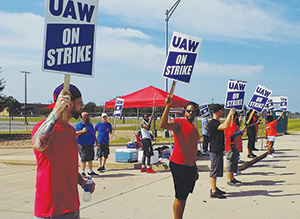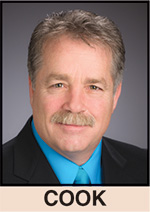
By TIM ROWDEN
Editor
Union density nationwide dropped to 10.3 percent last year, and Illinois union membership dropped slightly from 13.8 to 13.6, but union membership in Missouri grew by 46,000 members to 297,000, up to 11.1 percent from 9.4 percent in 2018.
Part of the Missouri jump can be attributed to new construction. Drive almost anywhere in the St. Louis area and you will see new buildings going up and cranes reaching into the skyline.
But union leaders suggest there’s something more at work in deep-red Missouri, where Republican state legislators have refused to accept voters’ defeat of anti-union “right-to-work” (RTW) legislation in 2018.
Republican legislators introduced bills this year and last to reimpose RTW in the state and are backing a pair of initiative petitions that would make RTW and a ban on prevailing wage requirements part of the Missouri Constitution.
Republican Gov. Mike Parson’s administration callously stopped deducting union dues from the paychecks of Missouri prison guards, putting pressure on the Missouri Correctional Officers Association as it works to negotiate a new contract for the state’s 5,000-plus guards and sergeants.
So what’s going on? With all of that downward pro-business, anti-worker pressure in Missouri, how is it that union membership is on the rise?
Labor’s ground game in defeating RTW (Prop A) and passing Proposition B, which raised the state’s minimum wage, undoubtably played a huge role in shifting public opinion about unions. As has the success of recent organizing efforts, contract negotiations and strike actions against recalcitrant employers unwilling to pay workers the wages they have earned and need to support their families. Many workers are starting to see the benefits of collective bargaining and what a union can do for them.
According to the Bureau of Labor Statistics, the average union member earned $1,095 a week last year, compared to $892 for non-union workers. Revisiting an old election year truism, “It’s the economy, stupid.”
 CHANGING OPINIONS ABOUT UNIONS
CHANGING OPINIONS ABOUT UNIONS
“You go back five or 10 years ago, when you said union organizing, a lot of people looked at you like they had a bad taste in their mouth,” said David Cook, president of United Food and Commercial Workers (UFCW) Local 655. “That’s gone now.”
Local 655 represents some 9,000 workers in retail food and non-food, healthcare, manufacturing, packing houses, distribution centers, laboratories, offices and hair care.
Although Local 655 lost some members last year as a result of grocery store closings and consolidation, they have added several hundred new members through increased organizing and reaching out to workers who are tired of working for little pay and few benefits, unpredictable schedules and little or no job security.
“I think it’s a reflection of the 1% not knowing when it’s enough,” Cook said. “I think it’s everyday workers feeling the pinch of the 1% strangle hold. I also think it’s the job of education Labor did in the ‘right-to-work’ and minimum wage fights and different ways of delivering our message to workers than we did before. There’s more of an openness and less of a dirty taste in their mouth when they say ‘union.’”
Pat White, president of the St. Louis Labor Council said “With Prop A (RTW), people saw the work that we put into that. They saw our commercials and our members going door-to-door and talking up unions and a lot of people want to get on board with that.
 “When you have grocery clerks, plumbers, electricians and members of other trades going door-to-door and at their kids games talking about how good it is to be in a union, I think the message just clicked with a lot of people,” he said. “What better way to get your union message out there than by talking with a happy union member?”
“When you have grocery clerks, plumbers, electricians and members of other trades going door-to-door and at their kids games talking about how good it is to be in a union, I think the message just clicked with a lot of people,” he said. “What better way to get your union message out there than by talking with a happy union member?”
White also credits outreach to under-represented communities through the St. Louis Building Trades Council’s BUD (Building Union Diversity) program, which has added some 200 new members to the union workforce.
JOB GROWTH
Job growth has impacted the membership numbers as well. Missouri’s construction industry, which is heavily unionized, grew by 4,000 jobs last year.
Manufacturing employment, though flat nationwide, has seen an uptick in Missouri. Boeing added 2,000 jobs last year, and the state’s auto industry, including General Motors in Wentzville and Ford in Kansas City, is thriving.
ORGANIZING VICTORIES
Jake Hummel, secretary-treasurer of the Missouri AFL-CIO, notes recent organizing victories, including about 300 cafeteria workers at St. Louis University, the University of Missouri-St. Louis and Webster University joining UNITE HERE, which represents workers in hotel, gaming, food service, manufacturing, textile, distribution, laundry, transportation, and airport industries. Another 75 employees at Virbac, a pet products manufacturer in Bridgeton, have unionized with the Teamsters.
“We’ve seen an uptick in organizing in recent years,” Hummel said.
LOCAL POLITICAL IMPACT
Though you wouldn’t know it by watching the state legislature, the growth in union membership and popularity is also having a political impact.
The St. Louis Board of Alderman recently voted to require contractors to pay workers the prevailing wage for skilled tradespeople in the area on projects worth more than $1 million that are receiving public money or incentives like tax abatements.
Prevailing wage laws require union and non-union construction workers to be paid state-set minimum wages on taxpayer-funded public works projects, including roads, bridges, schools and other public buildings –– ensuring projects are bid based on equipment, materials and overall project management, rather than on the wages of the employees.
St. Louis Aldermen sent the prevailing wage legislation to Mayor Lyda Krewson without opposition, and she is expected to sign the measure. St. Louis County Executive Sam Page signed a similar measure last November.
With the resurgence of union popularity in the state, White said politicians are now more comfortable backing such legislation.
“They’re not really putting their neck on the line now because of how popular unions are,” he said.



Thank you. Great Article. I have been involved in Union activities since 1972 against my Dad wishes. But I won out. It was a tough decision, but in the end Dad agreed with me. Then as a community member he supported me with getting a living wage. That was in 1988 when I was union president of our local. Our discussions were civil but he hated unions like Henry Ford. I was a teacher paying back loans from the 70’s for schooling. In Pennsylvania we used to be union with coal and steel, but those left. As well as our unions. BUT, as we grow as a state, people are realizing the political benefit of joining a union as they can crush you into thinking you are bad for joining a union. But we are not slaves, we deserve a living wage to get ahead for us and our children. Best of luck and keep it rolling in the South. Love…